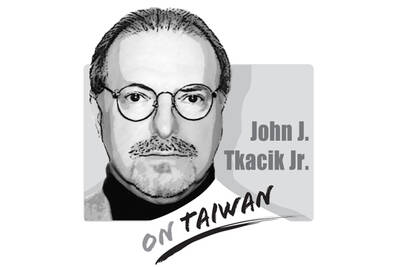Three fatal hiking incidents were among seven that required search-and-rescue operations during the 228 Memorial Day long weekend.
Nenggao Cross-Ridge Historic Trail (能高越嶺古道), where one of the fatal incidents occurred, is one of Taiwan’s top 15 hiking routes for which permits are required. During the long weekend, a hiker fell down a cliff and died, only six days after a similar fatal incident on the trail.
The government in October 2019 eased requirements and application procedures for 81 trails. When COVID-19 curbs were imposed a year later, many people flocked to the nation’s hiking trails.
Data from the National Fire Agency showed that the number of search-and-rescue missions after hiking incidents increased from 231 in 2019 to 608 in 2020, the highest in a decade. Even though trails were closed for two months during the pandemic, the agency counted 528 missions in 2021 and 566 last year.
From 2015 to 2021, the most common reasons for emergency calls were people “having gotten lost or reported missing” (43 percent), followed by “injuries” (20 percent), “illnesses and altitude sickness” (15 percent) and “falling off cliffs” (11 percent).
The vast majority of incidents were reported by self-organized hiking groups, accounting for 75.6 percent in 2020 and 68 percent in 2021, followed by solo hikers, accounting for 18 percent in 2020 and 12 percent in 2021.
National Airborne Service Corps data showed that it deployed helicopters for search-and-rescue operations 78 times in 2019. That number rose to 166 flights in 2020, 190 in 2021 and 170 last year.
The National Development Council in November last year announced a five-year project to increase the efficiency of mountain rescue operations. The project is to run from next year to 2028 and have a budget of NT$740 million (US$24.2 million), including for rescue equipment upgrades and boosting rescue training.
Several public hearings have been held in the past two years to better prevent hiking accidents. Mountain rescue professionals, hiking guides and experienced hikers expressed their concerns and made suggestions. Many of them said that unexperienced hikers might attempt difficult ascents, such as the most famous 100 peaks among Taiwan’s 268 mountains higher than 3,000m, after seeing pictures on social media, without being properly equipped or knowing the risks. Others might underestimate seemingly easier one-day hikes or be caught off guard by rapidly changing weather, while lacking essential equipment and enough water and food. They might overestimate their stamina and skills, and make unwise decisions.
Many prospective hikers seek out hiking partners or groups online. Such groups, consisting of members that do not know each other well, might not react appropriately and in a coordinated manner when facing emergency situations.
Tour guides leading commercial hiking groups vary greatly in terms of skill and qualifications, as there is no authority that oversees the sector. There is no regulation regarding the guide-to-hiker ratio, and while the Sports Administration issues certificates for hiking guides, no formal qualification is required to organize commercial hiking trips.
Hikers have the responsibility to be prepared when hitting the trails, but the government must also do its part. It should not only boost search-and-rescue capabilities, but create a unified difficulty rating system for trails, work with private-sector entities to provide safety information and regulate hiking companies. It should also determine which government agency is responsible. That could be the Sports Administration, the Forestry Bureau, the Tourism Bureau or the Ministry of the Interior.
Chinese agents often target Taiwanese officials who are motivated by financial gain rather than ideology, while people who are found guilty of spying face lenient punishments in Taiwan, a researcher said on Tuesday. While the law says that foreign agents can be sentenced to death, people who are convicted of spying for Beijing often serve less than nine months in prison because Taiwan does not formally recognize China as a foreign nation, Institute for National Defense and Security Research fellow Su Tzu-yun (蘇紫雲) said. Many officials and military personnel sell information to China believing it to be of little value, unaware that
Before 1945, the most widely spoken language in Taiwan was Tai-gi (also known as Taiwanese, Taiwanese Hokkien or Hoklo). However, due to almost a century of language repression policies, many Taiwanese believe that Tai-gi is at risk of disappearing. To understand this crisis, I interviewed academics and activists about Taiwan’s history of language repression, the major challenges of revitalizing Tai-gi and their policy recommendations. Although Taiwanese were pressured to speak Japanese when Taiwan became a Japanese colony in 1895, most managed to keep their heritage languages alive in their homes. However, starting in 1949, when the Chinese Nationalist Party (KMT) enacted martial law

“Si ambulat loquitur tetrissitatque sicut anas, anas est” is, in customary international law, the three-part test of anatine ambulation, articulation and tetrissitation. And it is essential to Taiwan’s existence. Apocryphally, it can be traced as far back as Suetonius (蘇埃托尼烏斯) in late first-century Rome. Alas, Suetonius was only talking about ducks (anas). But this self-evident principle was codified as a four-part test at the Montevideo Convention in 1934, to which the United States is a party. Article One: “The state as a person of international law should possess the following qualifications: a) a permanent population; b) a defined territory; c) government;
The central bank and the US Department of the Treasury on Friday issued a joint statement that both sides agreed to avoid currency manipulation and the use of exchange rates to gain a competitive advantage, and would only intervene in foreign-exchange markets to combat excess volatility and disorderly movements. The central bank also agreed to disclose its foreign-exchange intervention amounts quarterly rather than every six months, starting from next month. It emphasized that the joint statement is unrelated to tariff negotiations between Taipei and Washington, and that the US never requested the appreciation of the New Taiwan dollar during the